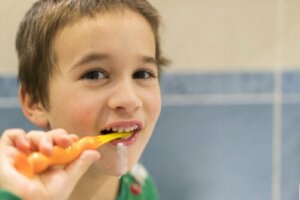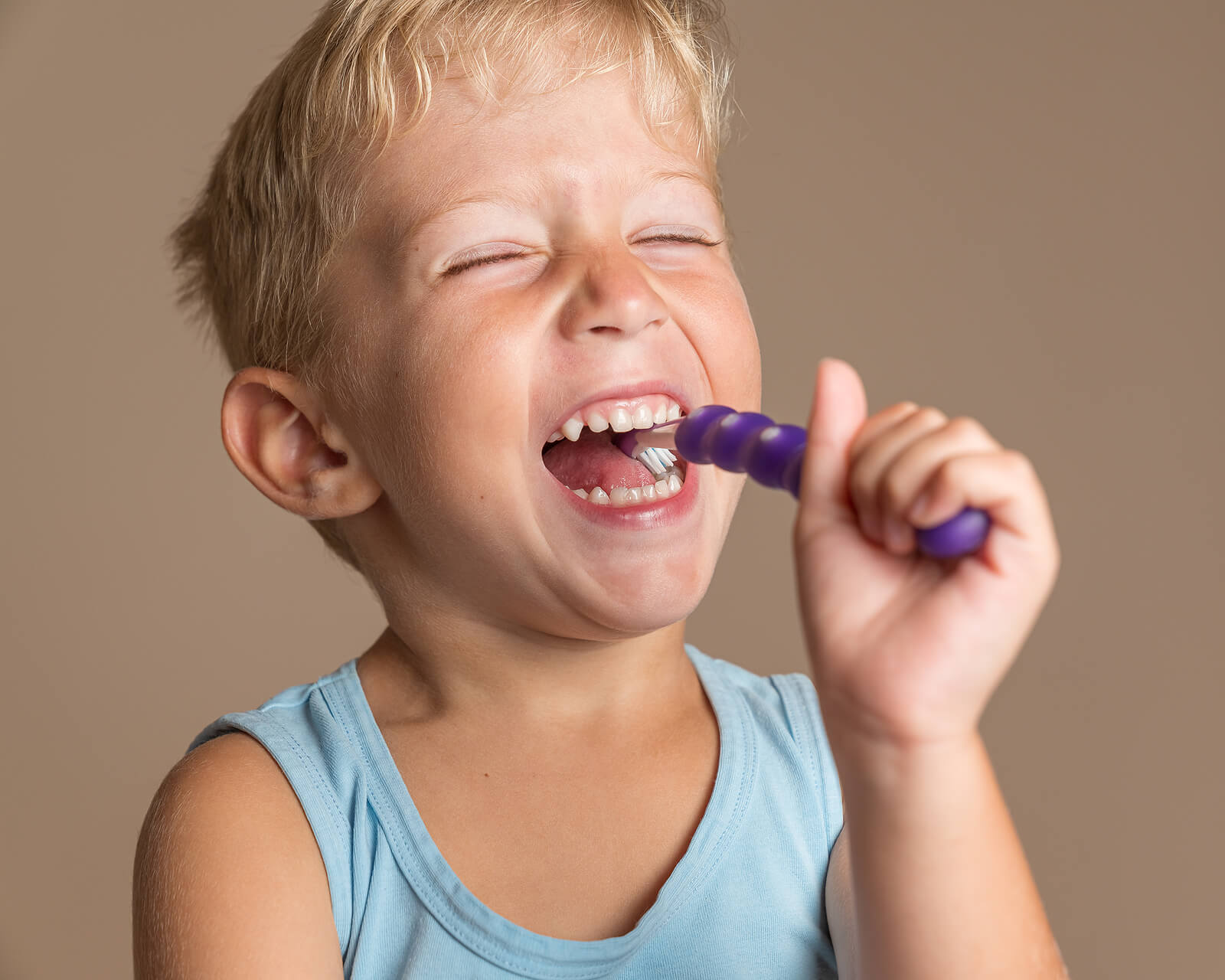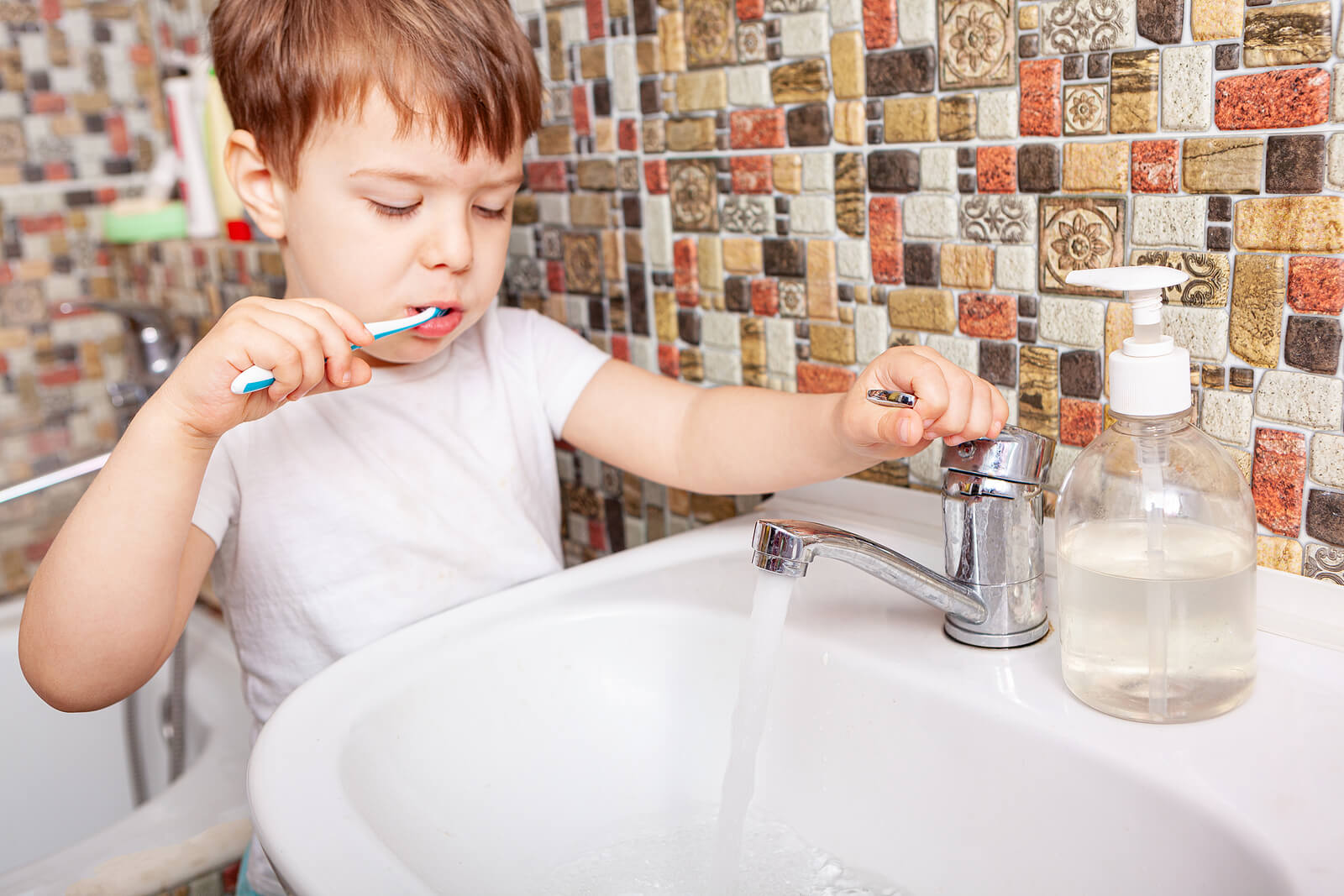Tartar on Children's Teeth

Tartar on children’s teeth is the result of the deposit of minerals on bacterial plaque that has accumulated on tooth surfaces. In addition to affecting the aesthetics of the mouth little ones, tartar produces bad breath and favors the inflammation of the gums.
As it can’t be removed with a toothbrush, a dentist must remove it. Find out in the following article how tartar is formed on children’s teeth. Also, find out how to treat it and what you can do to prevent its formation.
What is tartar and how is it formed?
Tartar on children’s teeth is a hard formation that’s yellowish-white or brown in the most severe cases, which is deposited on tooth surfaces and can’t be removed with regular toothbrushing. Its texture is rough, which favors the accumulation of more bacteria.

It’s the result of the calcification of bacterial plaque. This is a thin transparent film that covers the surfaces of the teeth and contains food debris and bacteria present in the mouth.
If bacterial plaque isn’t removed with proper tooth brushing, it accumulates and thickens more and more. The minerals present in the saliva are deposited on it, thus giving rise to tartar.
Although tartar can be found anywhere on the teeth, it’s most often seen on the inner surfaces of the lower incisors. In this sector is the exit of the ducts of the sublingual salivary glands and the excess of saliva that contains minerals favors the deposit of these on the bacterial plaque. In addition, it’s difficult for children to sanitize those sides of the dental pieces correctly.
Can all children have tartar?
It’s not very common to find tartar in children. In general, when it happens, it usually appears after 6 years of age. Some little ones are more predisposed to its formation and there are certain conditions that are also related to its presence:
- Poor dental hygiene: Incorrect or infrequent tooth brushing predisposes to tartar. Parents are responsible for controlling and supervising the dental cleansing of children.
- The incorrect position of the brush during toothbrushing: Sometimes children don’t know the correct hygiene technique and the bristles of the brush don’t reach the entire tooth surface. Cleaning the area where the teeth meet the gum is very important, as this is where plaque usually accumulates. Placing the brush vertically to reach the inner faces of the dental elements is another aspect that the little ones must learn and practice.
- Mouth breathing: Dryness of the mouth, especially at night, produces thicker saliva that favors the accumulation of bacteria and the formation of tartar.
- The use of medications: The use of aerosols and other medications, such as those used for the treatment of attention deficit, also produces thicker saliva that favors the adhesion of bacterial plaque to the teeth.
What to do if there’s tartar on children’s teeth?
Observing children’s mouths carefully and frequently makes it possible to verify that everything’s going well and to consult immediately when something strange is found. Seeing white or yellow plaque deposits on the child’s teeth and gums may be an indication that you need to go to the dental office.
In any case, even if you don’t notice anything strange, visits to the dentist every six months allow any problem that may occur in the mouth of children to be identified in time. It’s the professionals who will detect and diagnose any condition, suggesting the appropriate treatment. In addition, they’ll give the necessary advice and, if pertinent, they’ll make some change you take care of the mouth of the little ones.
As we already mentioned, tartar can’t be removed by brushing your teeth; its elimination can only be carried out by the dentist in the office, through dental cleaning or prophylaxis. This procedure consists of removing the tartar deposited on the teeth with specific dental instruments.
Tartar on children’s teeth can be prevented
The best way to prevent the formation of tartar on children’s teeth is to ensure that plaque doesn’t accumulate on their surfaces. This is achieved by performing proper oral hygiene at home.

Learning and practicing correct toothbrushing techniques is essential. Adults are in charge of supervising, helping, and controlling daily brushing and, if children aren’t yet capable of doing it effectively, it will be the adults who are in charge of it.
Brushing should be done with a soft bristle brush, with fluoride toothpaste, at least 3 times a day. The use of rinses and dental floss should complement the cleaning.
A varied and healthy diet that’s low in sugar also helps keep your mouth healthy. Drinking plenty of water and chewing sugar-free gum can help reduce the risk of tartar in children with dry mouth.
As we already mentioned, regular visits to the dentist, although everything seems to be fine, are also very necessary. The professional, in addition to advising and controlling, can detect any problem in time and carry out the appropriate treatments in a timely manner.
Home care is very important to prevent the teeth of the little ones from having tartar. Committed adults in the care of children’s mouths are the key for them to have a healthy smile.
Tartar on children’s teeth is the result of the deposit of minerals on bacterial plaque that has accumulated on tooth surfaces. In addition to affecting the aesthetics of the mouth little ones, tartar produces bad breath and favors the inflammation of the gums.
As it can’t be removed with a toothbrush, a dentist must remove it. Find out in the following article how tartar is formed on children’s teeth. Also, find out how to treat it and what you can do to prevent its formation.
What is tartar and how is it formed?
Tartar on children’s teeth is a hard formation that’s yellowish-white or brown in the most severe cases, which is deposited on tooth surfaces and can’t be removed with regular toothbrushing. Its texture is rough, which favors the accumulation of more bacteria.

It’s the result of the calcification of bacterial plaque. This is a thin transparent film that covers the surfaces of the teeth and contains food debris and bacteria present in the mouth.
If bacterial plaque isn’t removed with proper tooth brushing, it accumulates and thickens more and more. The minerals present in the saliva are deposited on it, thus giving rise to tartar.
Although tartar can be found anywhere on the teeth, it’s most often seen on the inner surfaces of the lower incisors. In this sector is the exit of the ducts of the sublingual salivary glands and the excess of saliva that contains minerals favors the deposit of these on the bacterial plaque. In addition, it’s difficult for children to sanitize those sides of the dental pieces correctly.
Can all children have tartar?
It’s not very common to find tartar in children. In general, when it happens, it usually appears after 6 years of age. Some little ones are more predisposed to its formation and there are certain conditions that are also related to its presence:
- Poor dental hygiene: Incorrect or infrequent tooth brushing predisposes to tartar. Parents are responsible for controlling and supervising the dental cleansing of children.
- The incorrect position of the brush during toothbrushing: Sometimes children don’t know the correct hygiene technique and the bristles of the brush don’t reach the entire tooth surface. Cleaning the area where the teeth meet the gum is very important, as this is where plaque usually accumulates. Placing the brush vertically to reach the inner faces of the dental elements is another aspect that the little ones must learn and practice.
- Mouth breathing: Dryness of the mouth, especially at night, produces thicker saliva that favors the accumulation of bacteria and the formation of tartar.
- The use of medications: The use of aerosols and other medications, such as those used for the treatment of attention deficit, also produces thicker saliva that favors the adhesion of bacterial plaque to the teeth.
What to do if there’s tartar on children’s teeth?
Observing children’s mouths carefully and frequently makes it possible to verify that everything’s going well and to consult immediately when something strange is found. Seeing white or yellow plaque deposits on the child’s teeth and gums may be an indication that you need to go to the dental office.
In any case, even if you don’t notice anything strange, visits to the dentist every six months allow any problem that may occur in the mouth of children to be identified in time. It’s the professionals who will detect and diagnose any condition, suggesting the appropriate treatment. In addition, they’ll give the necessary advice and, if pertinent, they’ll make some change you take care of the mouth of the little ones.
As we already mentioned, tartar can’t be removed by brushing your teeth; its elimination can only be carried out by the dentist in the office, through dental cleaning or prophylaxis. This procedure consists of removing the tartar deposited on the teeth with specific dental instruments.
Tartar on children’s teeth can be prevented
The best way to prevent the formation of tartar on children’s teeth is to ensure that plaque doesn’t accumulate on their surfaces. This is achieved by performing proper oral hygiene at home.

Learning and practicing correct toothbrushing techniques is essential. Adults are in charge of supervising, helping, and controlling daily brushing and, if children aren’t yet capable of doing it effectively, it will be the adults who are in charge of it.
Brushing should be done with a soft bristle brush, with fluoride toothpaste, at least 3 times a day. The use of rinses and dental floss should complement the cleaning.
A varied and healthy diet that’s low in sugar also helps keep your mouth healthy. Drinking plenty of water and chewing sugar-free gum can help reduce the risk of tartar in children with dry mouth.
As we already mentioned, regular visits to the dentist, although everything seems to be fine, are also very necessary. The professional, in addition to advising and controlling, can detect any problem in time and carry out the appropriate treatments in a timely manner.
Home care is very important to prevent the teeth of the little ones from having tartar. Committed adults in the care of children’s mouths are the key for them to have a healthy smile.
All cited sources were thoroughly reviewed by our team to ensure their quality, reliability, currency, and validity. The bibliography of this article was considered reliable and of academic or scientific accuracy.
- Alvear Cazar, Greace Katherine. Elaboración de un manual virtual de prevención de biofilm dental para niños de la Unidad Educativa “Daniel Enrique Proaño”. BS thesis. Quito: Universidad de las Américas, 2018., 2018.
- Andújar, Lewelyne Paniagua. “Índice de Higiene Oral (Placa Bacteriana) en dos centros del sector público.” Revista de Investigación y Evaluación Educativa 4.1 (2017): 14-21.
- Castro-Rodríguez, Yuri. “Enfermedad periodontal en niños y adolescentes. A propósito de un caso clínico.” Revista clínica de periodoncia, implantología y rehabilitación oral 11.1 (2018): 36-38.
- Girardeau, Clémence Shopie, Esther Alía García, and Marta Macarena Paz Cortés. “¿ Qué patologías locales y sistémicas puede presentar un paciente pediátrico con respiración oral?.” Biociencias 15.1 (2020).
- Sadashiva Murthy P, Shaik N, et al. effectiveness of plaque control with novel pediatric oral hygiene need station (modified oral irrigation device) as compared with manual brushing and flossing: randomized controlled pilot trial. Contemporary Clinical Dentistry. Abril-Junio 2018. 9 (2): 170-173.
- Sánchez Cachay, David Eduardo. Factores de riesgo asociado a la enfermedad periodontal en niños de la Isntitución Educativa Juana Moreno Huánuco 2017.” (2019).
- Vargas Vargas, Nancy Elena. Índice de placa bacteriana según Silness y Loe en la clínica de Odontopediatría. BS thesis. 2020.
This text is provided for informational purposes only and does not replace consultation with a professional. If in doubt, consult your specialist.








